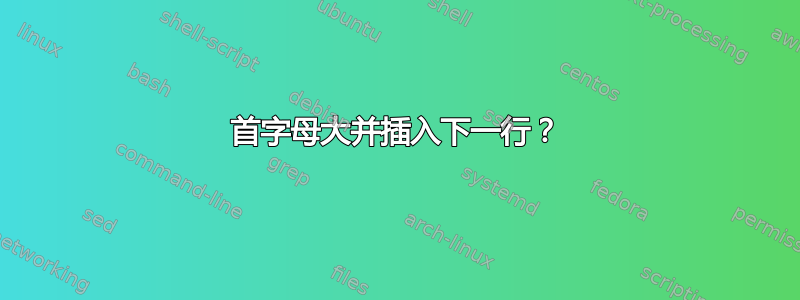
答案1
您可以使用该包lettrine来完成这项工作。
\documentclass{book}
\usepackage{newtxtext} % you want true small caps
\usepackage{lettrine}
\begin{document}
\chapter{Beginning}
\lettrine{F}{ew would quarrel} about the correct way to break boiled
eggs, but, as you probably know, there was even a civil war caused
by this very important question in the island of Lilliput. You may
also know that computer scientists took the names \emph{big-endian}
and \emph{little-endian} from Swift's `Gulliver's travels'.
\end{document}
但你似乎想要一个稍微不同的输出,莱特林(法语中意为“首字下沉”)向上突出。如果你输入
\lettrine[loversize=0.5]{F}{ew would quarrel}
那么输出将是
但不需要loversize=0.5每次都添加。只需在文档前言中添加适当的设置即可。
\documentclass{book}
\usepackage{newtxtext} % you want true small caps
\usepackage{lettrine}
% lettrine settings
\renewcommand*{\DefaultLoversize}{0.5}
%%%
\begin{document}
\chapter{Beginning}
\lettrine{F}{ew would quarrel} about the correct way to break boiled
eggs, but, as you probably know, there was even a civil war caused
by this very important question in the island of Lilliput. You may
also know that computer scientists took the names \emph{big-endian}
and \emph{little-endian} from Swift's `Gulliver's travels'.
\end{document}
个人观点:我永远不会使用首字下沉和次。
答案2
注:参见“使用 LaTeX 排版删除大写字母“ 也可以看看 ”如何增加章节中第一个字符的大小(Drop-Caps)“
我已经使用 lettrine 包有一段时间了:
我通过一个简单的定义使 lettrine 包可用:
%___________ Define \plett ____________
\makeatletter
\def\plett#1{%
\StrLeft{#1}{1}[\myfirstletter]%
\StrGobbleLeft{#1}{1}[\myrestofword]
\lettrine[lines=3]{\myfirstletter}{\trimright{\myrestofword}}
}
\makeatother
我发现,[lines=3]例如,下沉大写字母的高度和行数可以满足我的大部分需求,而且可以轻松调整。
如何应用\plett代码的典型示例是:
\plett{Fire can exist} in many forms. Over the course of human history, we have utilized fire in it’s many likenesses to accomplish what we otherwise could not. \par
为了增加效果,我调整了初始字符的颜色,如下所示:
\renewcommand{\LettrineFontHook}{\color{BrickRed}} % See LaTeX/Colors
我将 BrickRed 定义为:
\definecolor{BrickRed}{RGB}{144,44,30}
最后,我添加了\trimright函数(来自 SE发帖) 在函数中调用\plett(参见 MWE 中的“定义 \trimleft & \trimright”)。
%_________________________________________
\documentclass{article}
\usepackage{lettrine}
\usepackage{libertine}
\usepackage{lmodern}
\usepackage{xcolor}
\usepackage{xstring}
\definecolor{BrickRed}{RGB}{144,44,30}
%___________ Define \plett ____________
\makeatletter
\def\plett#1{%
\StrLeft{#1}{1}[\myfirstletter]%
\StrGobbleLeft{#1}{1}[\myrestofword]
\lettrine[lines=3]{\myfirstletter}{\trimright{\myrestofword}}
}
\makeatother
%________ Define \trimleft & \trimright _______
% Trimming whitespace around text (like LTRIM, RTRIM and TRIM)
\begingroup
%
% This plain TeX code uses the prefix "tsp", and defines
% \trim, \trimleft, and \trimright.
%
\catcode`@=11
\long\gdef\trim#1{\trimleft{\trimright{#1}}}
%
% Trimming spaces on the right is done by repeatedly calling \unskip
% until \lastskip is zero. We start with \hskip0pt\relax to stop
% \trimright from trimming spaces _before_ #1 in case this only
% contains spaces.
%
\long\gdef\trimright#1{\hskip0pt\relax #1\tsp@right}
\gdef\tsp@right
{\unskip\ifdim0pt=\lastskip\else\expandafter\tsp@right\fi}
%
% Trimming spaces on the left is done by repeatedly using \futurelet
% to test the first token, and dispatching depending on what is found.
% Expandable tokens are expanded; most assignments are performed;
% spaces are ignored; groups are entered. The loop ends when
% encountering \tsp@left@end.
%
\long\gdef\trimleft#1{\tsp@left#1\tsp@left@end}
\global\let\tsp@left@end\relax
\gdef\tsp@left{\expandafter\tsp@left@look}
\gdef\tsp@left@look{\futurelet\tsp@token\tsp@left@test}
\gdef\tsp@left@test
{%
\typeout{\meaning\tsp@token}%
\expandafter\ifx\noexpand\tsp@token\tsp@token
\expandafter\@secondoftwo
\else
\expandafter\@firstoftwo
\fi
{% Expandable token => expand again.
\let\tsp@next\tsp@left
}%
{%
\ifcat\tsp@token\relax
% Non-expandable primitive: build \tsp@<meaning>.
% Note that primitives for which I haven't defined
% \tsp@<meaning> just give \relax, which stops
% trimming cleanly.
\begingroup
\escapechar-1%
\global\expandafter\let\expandafter\tsp@next
\csname tsp@\meaning\tsp@token\endcsname
\endgroup
\else
% Character token.
\ifcat\tsp@token\bgroup % Begin-group: do; continue trimming
\bgroup\let\tsp@next\tsp@gobble@token
\else
\ifcat\tsp@token\egroup % End-group: do; continue trimming
\egroup\let\tsp@next\tsp@gobble@token
\else
\ifcat\tsp@token\space % Space: remove; continue trimming
\let\tsp@next\tsp@gobble@token
\else % Anything else: stop trimming
\let\tsp@next\relax
\fi
\fi
\fi
\fi
}%
\tsp@next
}%
\gdef\tsp@gobble@token{\afterassignment\tsp@left\let\tsp@token= }
%
% Helpers for defining primitives.
%
\long\gdef\tsp@swap#1{#1\tsp@gobble@token}
\gdef\tsp@assignment{\afterassignment\tsp@left}
%
% Various primitives
%
\global \let \tsp@unskip \tsp@gobble@token
\global \expandafter \let \csname tsp@ \endcsname \tsp@gobble@token
\global \let \tsp@begingroup \tsp@swap
\global \let \tsp@endgroup \tsp@swap
\global \let \tsp@def \tsp@assignment
\global \let \tsp@edef \tsp@assignment
\global \let \tsp@gdef \tsp@assignment
\global \let \tsp@xdef \tsp@assignment
\global \let \tsp@let \tsp@assignment
\global \let \tsp@futurelet \tsp@assignment
\global \let \tsp@global \tsp@assignment
\global \let \tsp@long \tsp@assignment
\global \let \tsp@protected \tsp@assignment
\gdef\tsp@hskip#1{\begingroup\afterassignment\tsp@hskip@\skip0= }
\gdef\tsp@hskip@{\endgroup\tsp@left}
%
% We must end when seeing \tsp@left@end (normally \relax)
%
\long\gdef\tsp@relax#1%
{%
\begingroup
\def\tsp@left@end{\tsp@left@end}%
\expandafter
\endgroup
\ifx#1\tsp@left@end
\else
\expandafter\tsp@left
\fi
}
\endgroup
\begin{document}
\renewcommand{\LettrineFontHook}{\color{BrickRed}} % See LaTeX/Colors
\renewcommand{\LettrineTextFont}{\rmfamily}
% \renewcommand*{\LettrineTextFont}{\scshape} % for French
\plett{Fire can exist} in many forms. Over the course of human history, we have utilized fire in it’s many likenesses to accomplish what we otherwise could not. \par
\end{document}
%_________________________________________
效果很好!







